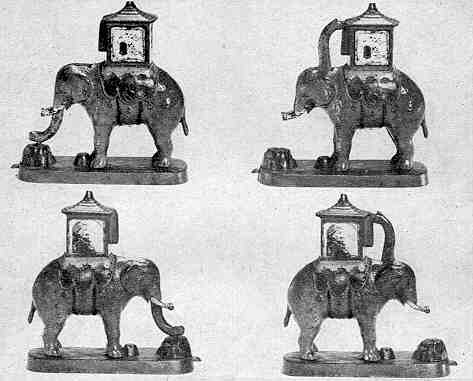Elephant Howdah (Locked)
by F.H. Griffith - HOBBIES Magazine - December, 1972

Well, at long last we have finally come up with an Elephant Howdah (Locked) that is an old original bank in all respects. In the writer’s opinion the bank pictured is completely authentic and this conclusion was reached after considerable personal careful examination of the bank itself. Since there is a difference in each side of the howdah and other factors, we are showing the bank from each side both before and after the action. At this point in the numerical classification the Elephant Howdah (Locked) is necessarily No. 215.
Mrs. Wally Tudor is the fortunate collector who discovered the bank recently and, of course, he has added it to his fine collection of mechanicals. It is in very nice condition with good paint and the colors are as follows: The peaked top of the howdah is dark red and the section under this is blue. The square recessed sections on both sides are white. The side with the figure cast therein depicts a black bearded man wearing a red hat and brown jacket. His facial coloring is natural. The blanket on the elephant is dark red trimmed in yellow with two black straps. The elephant is a green-gray color and he has white tusks with gold balls on the ends. The base is an off-shade of green and the two tree stumps thereon are brown. The underside of the base is a light green, and cast on the underside is the wording ‘Pat July 30 1900.’
Figures 1 and 2 show the bank before and after operation. The coin is placed in the end of the trunk when in the down position. Then the lever, just under the large tree stump on which the trunk of the elephant rests, is pressed down and the coin is thrown into the howdah as shown by the position in Figure 2. Please note in Figure 2 the two tree stumps on the base. The one by the elephant’s front legs serves the purpose of a spring container for the operating lever. This mechanism is on the underside of the base. Also note that the trunk of the elephant is a one-piece casting on this side. Further note that the locking coin trap is in the howdah.
Now to Figures 3 and 4 again showing the bank before and after operation. While not visible in Figure 3, it can be seen in Figure 4 that the trunk of the elephant is made in two parts on this side. It is made in this fashion to allow for the slot which holds the coin. And, of course, note the figure of the man in the howdah on this side and again the two tree stumps on the base. It is important to remember the tree stumps by the elephant’s front legs as this is one sure way to identify this original old bank. Another means of identification is the operating lever. It should not be a flat spring with a knob on the end, but rather, as on the bank shown, a well made cast iron lever held in place by two lugs and accentuated by a coil spring inserted in the small tree stump.
In closing, it is interesting to note that since M. Tudor’s great good fortune in acquiring this bank still another original one has turned up and they are, with one exception, identical. The word ‘Bank’ appears on the locking coin trap over the keyhole on this example and it was definitely made this way originally.
